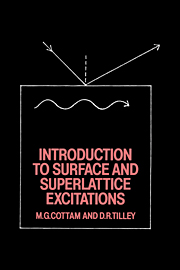Book contents
- Frontmatter
- Contents
- Preface
- 1 Introduction
- 2 Surface waves on elastic media and liquids
- 3 Surface magnons
- 4 Surface magnetostatic modes
- 5 Electronic surface states and dielectric functions
- 6 Surface polaritons
- 7 Layered structures and superlattices
- 8 Concluding remarks
- Appendix Green functions and linear response theory
- References
- Index
7 - Layered structures and superlattices
Published online by Cambridge University Press: 28 October 2009
- Frontmatter
- Contents
- Preface
- 1 Introduction
- 2 Surface waves on elastic media and liquids
- 3 Surface magnons
- 4 Surface magnetostatic modes
- 5 Electronic surface states and dielectric functions
- 6 Surface polaritons
- 7 Layered structures and superlattices
- 8 Concluding remarks
- Appendix Green functions and linear response theory
- References
- Index
Summary
A number of crystal growth techniques have been developed for the production of specimens which have the form of a succession of layers. In molecular-beam epitaxy (MBE) beams of atomic or molecular species passing through ultra-high vacuum impinge on a single-crystal substrate and in the right conditions crystal growth occurs epitaxially, that is, with the crystal structures in register. In metallo-organic chemical vapour-phase deposition (MOCVD) growth occurs by deposition from a flowing vapour. Both MBE and MOCVD are used to produce semiconductor specimens in which, for example, single-crystal layers of GaAs and A1xGa1-xAs alternate. Metallic specimens, including those in which one or both constituents may be magnetic, are made by sputtering. A review of MBE is given by Joyce (1985). Parker (1985) and Chang and Ploog (1985) include detailed chapters on MBE as well as on the physics of the resulting specimens, while the latter also contains a chapter on MOCVD.
The growth techniques can be used to prepare specimens consisting of alternating layers of thickness d1 of constituent 1 and thickness d2 of constituent 2. Specimens can be prepared so that d1 and d2 have any value from two or three atomic spacings up to the order of 100 nm typically.
- Type
- Chapter
- Information
- Introduction to Surface and Superlattice Excitations , pp. 247 - 301Publisher: Cambridge University PressPrint publication year: 1989

